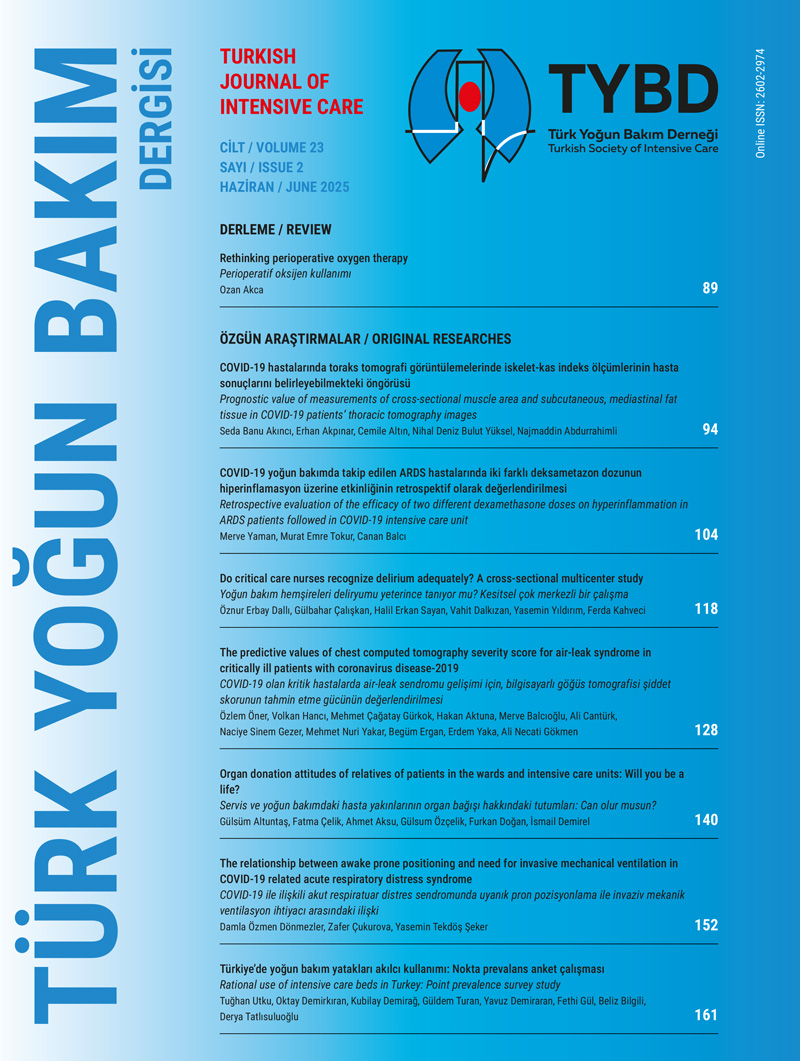Öz
Giriş ve Amaç: Koronavirus hastalığı-2019 (COVID-19) olan kritik hastalarda Air-Leak (AL) sendromunu önceden tahmin edebilmek ve risk faktörlerini bilmek morbidite ve mortaliteyi azaltabilir. Bu çalışmada, thoraks bilgisayarlı tomografi şiddet skorunun (CT-SS), AL gelişimini tahmin edip edemediğini araştırmayı amaçladık.
Yöntem ve Gereçler: COVID-19 hastaları, AL sendromu gelişip gelişmemesine göre iki gruba ayrıldı. Tüm hastalar için CT-SS hesaplandı. CT-SS’nin AL sendromunun gelişmesinin öngörme gücü ve AL için olası risk faktörleri araştırıldı.
Bulgular: Çalışmaya dahil edilen 272 hastanın 52’sinde (%19.1) AL sendromu gelişti. Medyan CT-SS Grup AL’da anlamlı derecede yüksekti. Grup AL’de CT-SS değeri 19(2-25), AL olmayan Grupda ise 13(1-25) idi (p değeri <0.001). CT-SS, AL oluşumunu tahmin etmede iyi tanısal performansa sahip olduğu tespit edildi (p<0.001). Grupların yoğun bakım mortalitesi karşılaştırıldığında AL olmayan grupta %42.3, AL grubunda ise %88.5 olduğu görüldü.
Tartışma ve Sonuç: CT-SS, COVID-19 ile beraber görülen AL sendromunun gelişiminde öngörme potansiyeli olabilir. Ancak bu konuda daha ileri çalışmalara ihtiyaç vardır.
Anahtar Kelimeler: COVID-19, yoğun bakım ünitesi, air-leak sendromu, BT şiddet skoru, mortalite
Referanslar
- Shahsavarinia K, Rahvar G, Soleimanpour H, Saadati M, Vahedi L, Mahmoodpoor A. Spontaneous pneumomediastinum, pneumothorax and subcutaneous emphysema in critically ill COVID-19 patients: A systematic review. Pak J Med Sci. 2022;38:730-5. https://doi.org/10.12669/pjms.38.3.5529
- Ochani R, Asad A, Yasmin F, et al. COVID-19 pandemic: from origins to outcomes. A comprehensive review of viral pathogenesis, clinical manifestations, diagnostic evaluation, and management. Infez Med. 2021;29:20-36.
- Quincho-Lopez A, Quincho-Lopez DL, Hurtado-Medina FD. Case Report: Pneumothorax and Pneumomediastinum as Uncommon Complications of COVID-19 Pneumonia-Literature Review. Am J Trop Med Hyg. 2020;103:1170-6. https://doi.org/10.4269/ajtmh.20-0815
- Adeyinka A, Pierre L. Air Leak. In: StatPearls. Treasure Island (FL): StatPearls Publishing; 2022.
- Akboga SA, Gokce A, Hatipoglu M, et al. The relationship between mortality and inflammatory markers and the systemic immune inflammatory index in patients in the intensive care unit with a pneumothorax as a complication of COVID-19 disease. Ir J Med Sci. 2022;191:1931-6. https://doi.org/10.1007/s11845-021-02740-x
- Brito J, Gregório P, Mariani A, et al. Pneumomediastinum in COVID-19 disease: Outcomes and relation to the Macklin effect. Asian Cardiovasc Thorac Ann. 2021;29:541-8. https://doi.org/10.1177/02184923211010089
- Marsico S, Del Carpio Bellido LA, Zuccarino F. Spontaneous Pneumomediastinum and Macklin Effect in COVID-19 Patients. Arch Bronconeumol. 2021;57:67. https://doi.org/10.1016/j.arbres.2020.07.030
- Elhakim TS, Abdul HS, Pelaez Romero C, Rodriguez-Fuentes Y. Spontaneous pneumomediastinum, pneumothorax and subcutaneous emphysema in COVID-19 pneumonia: a rare case and literature review. BMJ Case Rep. 2020;13:e239489. https://doi.org/10.1136/bcr-2020-239489
- Alsharif W, Qurashi A. Effectiveness of COVID-19 diagnosis and management tools: A review. Radiography (Lond). 2021;27:682-7. https://doi.org/10.1016/j.radi.2020.09.010
- Simpson S, Kay FU, Abbara S, et al. Radiological Society of North America Expert Consensus Statement on Reporting Chest CT Findings Related to COVID-19. Endorsed by the Society of Thoracic Radiology, the American College of Radiology, and RSNA - Secondary Publication. J Thorac Imaging. 2020;35:219-27. https://doi.org/10.1097/RTI.0000000000000524
- Chang YC, Yu CJ, Chang SC, et al. Pulmonary sequelae in convalescent patients after severe acute respiratory syndrome: evaluation with thin-section CT. Radiology. 2005;236:1067-75. https://doi.org/10.1148/radiol.2363040958
- Juneja D, Kataria S, Singh O. Air leaks in COVID-19. World J Virol. 2022;11:176-85. https://doi.org/10.5501/wjv.v11.i4.176
- Ebrahimi A, Yousefifard M, Mohammad Kazemi H, et al. Diagnostic Accuracy of Chest Ultrasonography versus Chest Radiography for Identification of Pneumothorax: A Systematic Review and Meta-Analysis. Tanaffos. 2014;13:29-40.
- Rollas K, Çalışkan T, Yavuz T, Güldoğan IK. Pneumothorax and Pneumomediastinum in Patients admitted to Intensive Care Unit with COVID-19 Pneumonia: A Single-Center Retrospective Analysis. Journal of Cardio-Vascular-Thoracic Anaesthesia and Intensive Care Society. 2022;28:178-83. https://doi.org/10.14744/GKDAD.2022.54366
- Zakariaee SS, Salmanipour H, Naderi N, Kazemi-Arpanahi H, Shanbehzadeh M. Association of chest CT severity score with mortality of COVID-19 patients: a systematic review and meta-analysis. Clin Transl Imaging. 2022;10:663-76. https://doi.org/10.1007/s40336-022-00512-w
- Aziz-Ahari A, Keyhanian M, Mamishi S, et al. Chest CT severity score: assessment of COVID‑19 severity and short-term prognosis in hospitalized Iranian patients. Wien Med Wochenschr. 2022;172:77-83. https://doi.org/10.1007/s10354-022-00914-5
- Simioli F, Annunziata A, Polistina GE, Coppola A, Di Spirito V, Fiorentino G. The Role of High Flow Nasal Cannula in COVID-19 Associated Pneumomediastinum and Pneumothorax. Healthcare (Basel). 2021;9:620. https://doi.org/10.3390/healthcare9060620
- Kayhan O, Demirkıran O, Ürkmez S, Dikmen Y. Air leaks in COVID-19 pneumonia. Turk Gogus Kalp Damar Cerrahisi Derg. 2022;30:281-5. https://doi.org/10.5606/tgkdc.dergisi.2022.20763
- Nasa P, Juneja D, Jain R. Air leak with COVID-19 - A meta-summary. Asian Cardiovasc Thorac Ann. 2022;30:237-44. https://doi.org/10.1177/02184923211031134
- Jones E, Gould A, Pillay TD, et al. Subcutaneous Emphysema, Pneumomediastinum, and Pneumothorax in Critically Ill Patients With Coronavirus Disease 2019: A Retrospective Cohort Study. Crit Care Explor. 2020;2:e0210. https://doi.org/10.1097/CCE.0000000000000210
- Xu Z, Shi L, Wang Y, et al. Pathological findings of COVID-19 associated with acute respiratory distress syndrome. Lancet Respir Med. 2020;8:420-2. https://doi.org/10.1016/S2213-2600(20)30076-X
- Salehi S, Abedi A, Balakrishnan S, Gholamrezanezhad A. Coronavirus Disease 2019 (COVID-19): A Systematic Review of Imaging Findings in 919 Patients. AJR Am J Roentgenol. 2020;215:87-93. https://doi.org/10.2214/AJR.20.23034
- Esnault P, Cardinale M, Hraiech S, et al. High Respiratory Drive and Excessive Respiratory Efforts Predict Relapse of Respiratory Failure in Critically Ill Patients with COVID-19. Am J Respir Crit Care Med. 2020;202:1173-8. https://doi.org/10.1164/rccm.202005-1582LE
- Marini JJ, Gattinoni L. Management of COVID-19 Respiratory Distress. JAMA. 2020;323:2329-30. https://doi.org/10.1001/jama.2020.6825
- Battaglini D, Robba C, Ball L, et al. Noninvasive respiratory support and patient self-inflicted lung injury in COVID-19: a narrative review. Br J Anaesth. 2021;127:353-64. https://doi.org/10.1016/j.bja.2021.05.024
- Pinto EF, Santos RS, Antunes MA, et al. Static and Dynamic Transpulmonary Driving Pressures Affect Lung and Diaphragm Injury during Pressure-controlled versus Pressure-support Ventilation in Experimental Mild Lung Injury in Rats. Anesthesiology. 2020;132:307-20. https://doi.org/10.1097/ALN.0000000000003060
- Tonelli R, Bruzzi G, Manicardi L, et al. Risk Factors for Pulmonary Air Leak and Clinical Prognosis in Patients With COVID-19 Related Acute Respiratory Failure: A Retrospective Matched Control Study. Front Med (Lausanne). 2022;9:848639. https://doi.org/10.3389/fmed.2022.848639
- Pun BT, Badenes R, Heras La Calle G, et al. Prevalence and risk factors for delirium in critically ill patients with COVID-19 (COVID-D): a multicentre cohort study. Lancet Respir Med. 2021;9:239-50. https://doi.org/10.1016/S2213-2600(20)30552-X
- Boussarsar M, Protti A. Pulmonary air leak in COVID-19: time to learn from our mistakes. Intensive Care Med. 2022;48:1614-6. https://doi.org/10.1007/s00134-022-06866-z
- Zantah M, Dominguez Castillo E, Townsend R, Dikengil F, Criner GJ. Pneumothorax in COVID-19 disease- incidence and clinical characteristics. Respir Res. 2020;21:236. https://doi.org/10.1186/s12931-020-01504-y
- Yang X, Yu Y, Xu J, et al. Clinical course and outcomes of critically ill patients with SARS-CoV-2 pneumonia in Wuhan, China: a single-centered, retrospective, observational study. Lancet Respir Med. 2020;8:475-81. https://doi.org/10.1016/S2213-2600(20)30079-5
- Knox DB, Brunhoeber A, Peltan ID, Brown SM, Lanspa MJ. Comparison of radiographic pneumothorax and pneumomediastinum in COVID-19 vs. non-COVID-19 acute respiratory distress syndrome. Intensive Care Med. 2022;48:1648-51. https://doi.org/10.1007/s00134-022-06816-9
- Housman B, Jacobi A, Carollo A, et al. COVID-19 ventilator barotrauma management: less is more. Ann Transl Med. 2020;8:1575. https://doi.org/10.21037/atm-20-3907
Telif hakkı ve lisans
Telif hakkı © 2025 Yazar(lar). Açık erişimli bu makale, orijinal çalışmaya uygun şekilde atıfta bulunulması koşuluyla, herhangi bir ortamda veya formatta sınırsız kullanım, dağıtım ve çoğaltmaya izin veren Creative Commons Attribution License (CC BY) altında dağıtılmıştır.






















